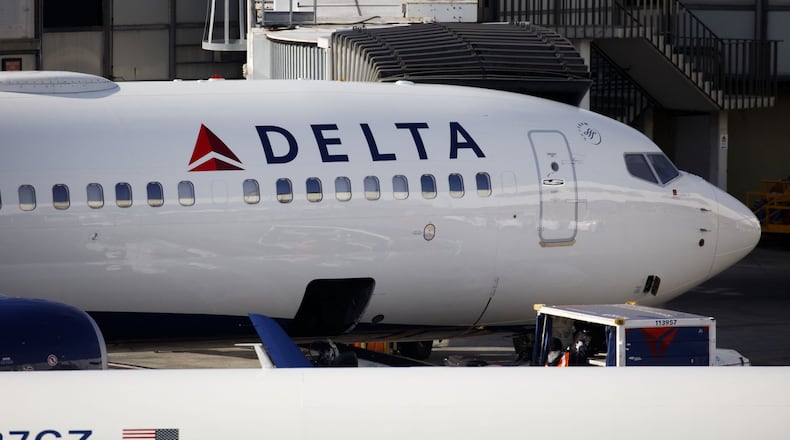In the 10 years since Delta Air Lines acquired Northwest Airlines, the Atlanta-based carrier has transformed itself from a struggling company fresh out of bankruptcy into a financial powerhouse.
Along the way to making billions of dollars in profits a year, Delta has also expanded its workforce in Georgia and vastly improved its on-time performance.
But it hasn't been all smooth sailing.
Within a few months of its merger, a recession drove the company to cut staff and slash flights. Within a few years, the airline was also selling off facilities.
"We went through takeover battles. We went through a bankruptcy. It was always about keeping Delta my Delta," said Delta CEO Ed Bastian, referring to the tagline the company used when rallying its employees to fend off a 2006 hostile takeover by US Airways.
It eliminated hubs in Cincinnati and Memphis and down-scaled its Tokyo hub, while adding hubs in Seattle, Los Angeles and New York's LaGuardia Airport and international hubs with partners.
But, after all the growing pains, “We’ve created the most valuable airline in the world,” Bastian said.
Minneapolis to Atlanta
When Delta announced its merger with Northwest, then-CEO Richard Anderson said the consolidation was “about addition, not subtraction.” The merger agreement closed Oct. 29, 2008.
The deal allowed the company to keep the name Delta and maintain its headquarters in Atlanta.
Delta consolidated operations and shut down flight training and maintenance facilities at Northwest’s old campus in the Minneapolis area.
Delta had committed to keep a “Delta North” headquarters in Minnesota along with at least 10,000 jobs there as part of assuming bond debt from Northwest in the merger. Instead, Delta paid off the bond debt early and shut down the Delta North headquarters.
Ultimately, much of the work was shifted to Atlanta, where Delta has a massive headquarters campus by Hartsfield-Jackson and operates its largest hub by far, with about 1,000 departures a day. In Georgia, Delta now has more than 33,000 employees, up from about 25,000 at the time of the merger.
The airline industry has been shifting toward lucrative international routes for growth, and the merger helped Delta with that transition.
But some smaller towns are left without airline service as a result.
“If you’re in one of the markets that lost service because no one in the [airline] industry is bothering to serve that particular small city anymore, then Delta didn’t help you,” said Robert W. Mann, an airline consultant based in Port Washington, N.Y.
But by and large, he said, travelers in many big cities have more service to cities around the world.
Combining workforces
The Delta-Northwest merger triggered a series of difficult union battles, as Northwest’s highly unionized workforce meshed with Delta’s mostly non-union workforce.
For the most part, the combined airline’s workforce voted against unionization. Delta remains mostly that way, with the pilots as its major unionized work group.
Since the merger, Delta has returned to a “paternalistic” culture similar to its early days under founder C.E. Woolman, Mann said.
That includes huge profit sharing checks paid out to employees every Valentine’s Day and big pay raises. “Of course, you can do that when you’re minting money” the way Delta is, Mann said.
Wave of mergers
The Delta-Northwest deal also kicked off a series of major airline mergers, including United-Continental, American-US Airways and Southwest-AirTran.
Other airline executives looked to the Delta-Northwest deal as a model for how to integrate two airlines, including getting a pilot deal done before the merger and quickly deciding on IT systems for a combined company, Mann said.
“Previously, these things resulted in a lot of hand-waving and hand-wringing, hair-on-fire sorts of rationalizations as to what to do,” Mann said. Other airlines have looked to “maybe accomplish them as elegantly as Delta and Northwest did.”
Delta had the advantage of being first. After the acquisition, other airlines were still wrestling with their own merger challenges, but Delta “was ruthless and smart,” said Phoenix-based airline consultant Hubert Horan. Delta’s attitude, he said, was, “We’re going to take (being first) and make it an even bigger advantage,” by improving its airplane fleet and investing in systems.
Some are critical of the airline industry consolidation and its effect on competition and consumers.
Ultimately, Horan said, the wave of airline mergers was intended to “massively reduce competition in the airline business, of which Delta was one of the key players and it’s one of the major dominoes.”
He says global airline deals, starting with Air France-KLM, began an industry-wide shift that ended with three major U.S. carriers controlling the international market — Delta, American and United. Their respective airline alliances keep a lock on the lucrative market for flights between the U.S. and Europe.
“It’s a permanent three-player oligopoly, forever,” Horan said.
Such a system can reduce competition and result in higher prices for consumers.
In some markets, Horan said, the airlines may be “losing tons of money.”
And then, there are “plenty of places where they’re minting money,” he said.
With United, American and Delta reporting billions in profit last year, he said, “The bottom line suggests that the latter greatly outweighs the former.”
Delta-Northwest merger: 10 years later
Delta and Northwest merged Oct. 29, 2008. Here’s what has happened since.
Customer count then: 171 million+
Now: 192 million+
Average fares then: $161 each way, or $191 adjusted for inflation
Now: $189 each way
On-time arrivals then: 77.2 percent
Now: 85.3 percent
Employees then: 48,400 Delta and 29,200 Northwest
Now: 80,000+
Annual revenue then: $22.7 billion
Now: $41.2 billion
Market cap then: $2.5 billion
Now: $35.7 billion
Fleet then: 578 planes
Now: 867 planes
Partnerships with other airlines then: Air France
Now: Air France-KLM, Virgin Atlantic, Aeromexico, GOL, China Eastern, Korean Air
Source: Delta Air Lines
About the Author
Keep Reading
The Latest
Featured



